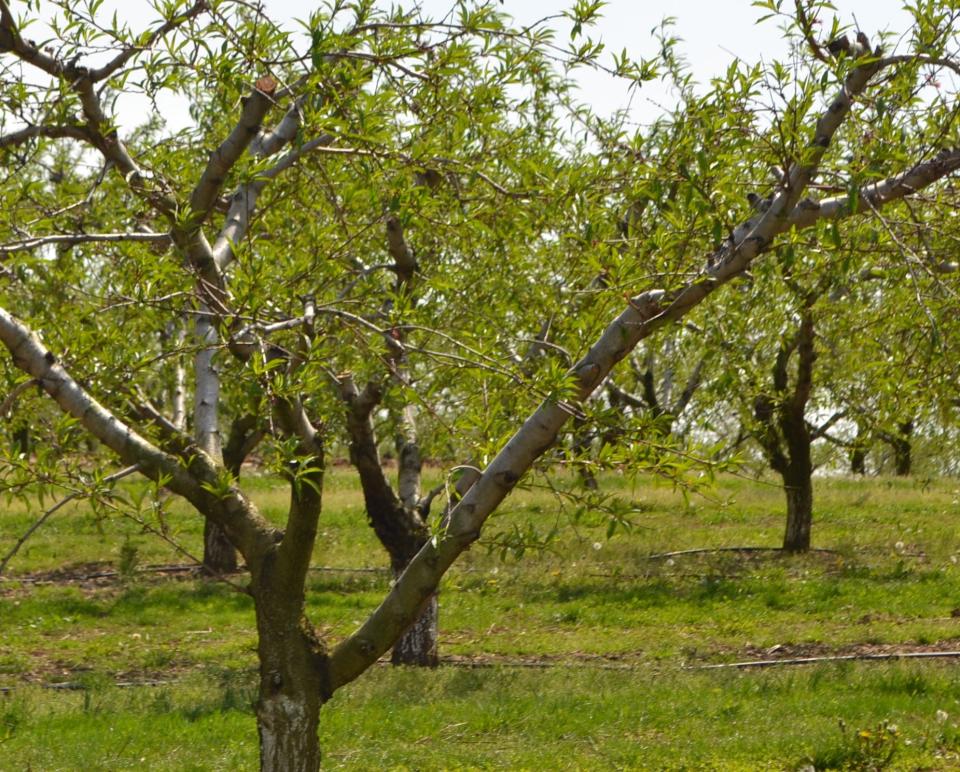A Stroll Through the Garden: Peach leaf curl and tips for fertilizing your trees
I was at a pool this week getting my exercise and looking forward to Friday the 13th. This is my three-month anniversary visit with my surgeon about my hip replacement surgery. Hopefully my restrictions will be removed.
One of my readers in the pool asked me about peach leaf curl. He wanted to know how to fertilize his new peach trees after he had removed the old trees that had peach leaf curl. He selected some varieties that are resistant to the disease, which I think is a good idea.
Peach leaf curl, also known as leaf curl, is a disease caused by the fungus Taphrina deformans. Peach leaf curl affects the blossoms, fruit, leaves and shoots of ornamental flowering and nectarines. It is one of the most common disease problems for gardeners growing these trees. The distorted reddened foliage it causes is easily seen in spring. When severe, the disease can reduce fruit production substantially.
The fungus survives the hot dry summer as ascospores and bud-conidia (asexual spores) on the tree’s surfaces. When the weather turns cool and wet in fall, the ascospores germinate to produce more bud-conidia on the tree’s surface. In spring, the bud-conidia move by splashing water from irrigation or rain and can infect new leaves.
Test soil before fertilizing
Before you add any fertilizer, test the soil and find out where the levels of N x P x K are so you know what to add. Organic gardening recommends you would use a good compost where you planted the tree.
Peach trees do their best in well-drained and sandy light soil with a heavier texture below the surface and soils of between 6.5 and 6 on the pH scale. If you measure the pH above 6.2 don’t add lime because the higher level of calcium reduces the absorption of potassium and magnesium by the tree roots.
Most of the time if you are not doing organic gardening, you can use a 10 x 10 x 10 granular fertilizer for your trees. Make sure you are at least 12 inches away from the trunk of the peach tree and newly planted trees use only ½ cup of the fertilizer. If you place the fertilizer too close to the new trees, you may cause damage to the trees where they won’t take the nutrients up. Further out will cause the roots to stretch to the fertilizer. A good compost tea dumped over the soil will also encourage microbe growth including mycelium growth in the soil.
Newly planted trees should be fertilized once a week, and then later, a month and a half afterward. This will help your peach tree to become established. For established trees you need to fertilize your trees early in the spring and late spring or early in the summer.
You do want to harden the tree off before winter, so don’t fertilize with much of anything beyond early July. A healthy peach tree will grow 1 - 1½ inches per year. You can modify the fertilizer rates. Yellow-green leaves and reddish leaves indicate that there is a nutrient problem. With a 2-3 inch thick layer of mulch you may find that the mulch will keep the soil a little while longer and may help the flowers bud a little later in the season because the roots will be cooler.

Good source of watering are drip lines
I have liked the idea of irrigating peach trees with drip lines. Drip lines don’t spray the plants that will encourage disease spread. Spread the lines under the canopy of the tree to get water to the roots. Keep in mind that as you water peaches they become juicier.
Hope you have a good stroll through your garden. I have really enjoyed all the plants in bloom. I have my creeping phlox, Texas flowering quince, Korean spicebush viburnum, Japanese kerria, hyacinths, apple trees and more in bloom.
If you have any challenges as you walk through your gardens, drop me an e-mail at ericlarson546@yahoo.com. When I’m able to put my blog on my website at ohiohealthyfoodcooperative.org the columns will get updated. I shall do the best I can to answer you. Thank you for participation in our column.
Eric Lawson of Jeromesville is a veteran landscaper and gardening enthusiast and a founding board member of the Ohio Chapter of Association of Professional Landscape Designers.
This article originally appeared on Mansfield News Journal: A Stroll Through the Garden: How to fertilize your peach trees

